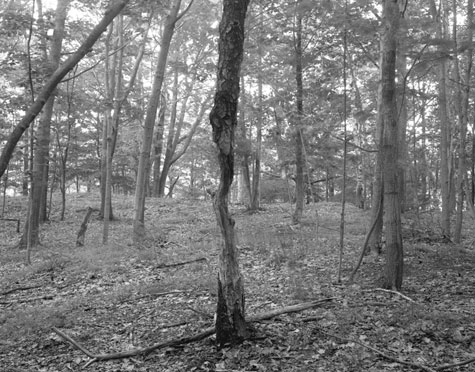
‘SPECIES’ SERIES Strong images painstakingly labeled. CREDIT COLE CASWELL |
Living on an island can be like living in your parents’ basement. Remove the pesky issues of social interaction and economic dependency, and you can rehearse any worldview you like. In the TV series Survivor, the island is cast as an antagonistic playground for social Darwinism. In Lost, it’s a floor exercise for undergraduate political philosophy masked as modern dystopian fantasy.
In the 21 pieces in “Patches Within Proximity,” the spring USM exhibit by Peaks Island-based art duo Cole Caswell and Jessica George, the island becomes a deterritorialized subject. There is no formal orthodoxy (the pieces include oil-based paintings, photography, a Sharpie drawing, tintypes, spider sarcophagi, a text-archive installation, and an interactive tracking device), no test site for sociological experimentation, and nobody getting voted off.
Operating as “The Geographic Observatory” — the artists’ alias for their Peaks-specific ecological investigations — Caswell and George work deliberately, formally scientific in tone but marginalized, almost post-industrial in scope (some of the texts in the archival installation provide post-technological survival tips).
As with much island-themed art, the Peaks depicted is an experiment with a closed ecosystem. But if it appears that Caswell and George are guilty of treating Peaks like a personal terrarium, the careful methodology of their work suggests otherwise. The sheer diversity and inventiveness of form suggest the slow development of a miniature cosmogony, moving cartography beyond its current dimensions.
Take the three inkjet photographs from 2008’s “Species” series, in which black-and-white images taken from remote points on the island are meticulously organized by underwritten “species ID tags.” The flora are ordered by proximity — as opposed to taxonomy — and labeled (sometimes repetitiously) by common name, not Latin. A second or third occurrence of an oak tree is as urgently documented as the first.
In the “Ecological Patch” series, four bleak, topographical tintypes map the colonization of Peaks Island between 1837 through 1926. Perhaps because tintype is a medium that lends itself so readily to portraiture (Caswell and George work heavily with tintype in their non-studio iteration “we are x”), the maps seem animate, insectile. Beginning with the legs of the docks, cavernously black patches stretch incrementally across a negative image of the island, suggesting yet another creature in the artists’ taxonomy of island life. The understanding that the artists make their home somewhere in this void is an aspect of the exhibit, though from the vantage provided in the “Ecological Patch” series, the ecosystem is impenetrable from a gallery.
The two plates in the “Interior Arachnid Territory Tracking Kit” series each display a petrified spider, its preserved web, and an aborted attempt at a two-dimensional transcoding of the web drawn by Caswell. Here, another aspect of The Geographical Observatory’s efforts is observed. Perhaps life on the island can be better understood from the perspective of a spider. Perhaps, with effort, the artists can become spiders, treating their island home with the painstaking delicateness with which one crafts a web.
In its eager curiosity, “Patches Within Proximity” aims to raise more question than answers. Thankfully, Caswell and George are scheduled to appear (on the mainland!) at ArtTalk at on Friday, April 9 at 1 pm, at Burnham Lounge, Robie Andrews Hall on USM’s Gorham campus.
Nicholas Schroeder can be reached atmrnicholasschroeder@gmail.com.
“PATCHES WITHIN PROXIMITY: COLE CASWELL AND JESSICA GEORGE” | through April 30 | at AREA Gallery, Woodbury Campus Center, Bedford St, Portland | 207.780.5009